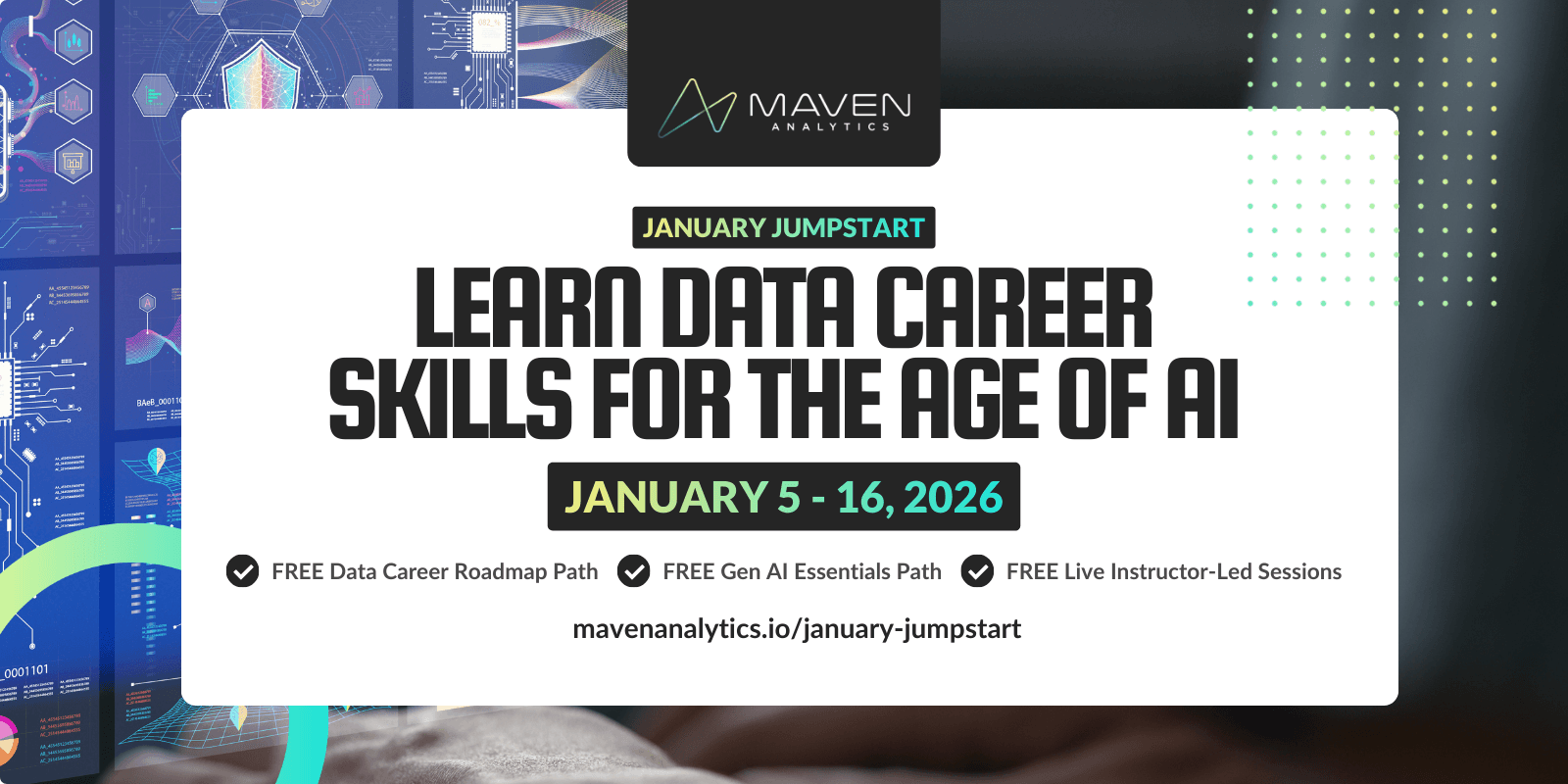When I first heard about Maven's upcoming Machine Learning series, I had questions.
I typically associate Machine Learning with heavy stats, and programming languages like Python and R.
But... Microsoft Excel? Not so much.
If I'm being honest, I was pretty skeptical. I wasn't sure teaching Machine Learning using our old friend Excel was the best approach.
Then I interviewed Chris about it, AT LENGTH :)
Now I'm fully bought in.
Below is a transcript of our conversation. Enjoy!
JP - Before we get into specifics, what made you want to add Machine Learning to the Maven library?
CD - At Maven, we made our name in the business intelligence space, teaching core analytics skills with tools like Excel, SQL, Power BI and Tableau. While we plan to continue adding depth to those paths, we've also heard from many students looking to explore new topics like data science & machine learning for the first time.
The thing is, most student are excited about the idea of data science, but anxious about learning complex programming languages or intimidated by terms like "naive bayes", "logistic regression", "KNN" and "decision trees". At least I know I was :)
We wanted to make data science more accessible to "mainstream" analytics folks, and build courses designed to demystify core ML topics without trying to teach a coding language at the same time. By using familiar tools like Excel to break down complex topics, we can help people understand exactly how and why this stuff works before trying to apply it using Python or R.
JP - Would you say there's a lot of overlap between the worlds of Data Science/Machine Learning and BI?
CD - Absolutely. I think people get way too caught up in labels and terminology, when in reality we're all out here doing the same thing: using data to make smart decisions.
The differences lie in the types of analyses we tend to perform (descriptive, predictive, prescriptive) and the tools we use to conduct them. I think it's time to shift away from the "Data Science vs. Business intelligence" mentality, and spend more time talking about how much these worlds overlap and how they can work together to accomplish amazing things (which is something I discuss in depth in our Why BI? video series).
JP - Why teach this course with Excel instead of Python or R? Aren't those the best tools for the job?
CD - Excel is a surprisingly powerful tool for teaching analytics, because it allows you to expose data, logic, and presentation layers all within an intuitive and user-friendly interface. Believe it or not, Excel is a full-stack programming tool!
While it's absolutely NOT the right fit for deploying machine learning models in production, we can use it to break down and reverse engineer algorithms like K-nearest neighbors, decision trees, logistic regression, markov chains, and sentiment analysis to show users exactly what's happening under the hood, in a way that would be impossible using a programming language like Python.
JP - Can Data Analysts handle this type of course? Or is it just for Data Science pros?
CD - I think a big reason why so many people struggle with the data science learning curve is that they are trying to learn two fundamentally different things at the same time:
How to write code
How machine learning algorithms work
By separating these two objectives and focusing on the core concepts first, we're able to simplify the learning experience and make machine learning approachable to students of all experience levels. No PhD or computer science background required!
JP - Maven brought on Josh MacCarty as the instructor for this series. What's his deal?
CD - Josh and I first crossed paths back in 2014, working for the same agency. I was building a BI team in Boston while he was building a Data Science team out of Pittsburgh, so we collaborated on a lot of projects. My first impression of Josh was that he was ridiculously smart and equally laid-back; no matter how tough clients got or what crazy hoops they had us jumping through, Josh would just grin and roll with it.
My second impression of Josh was that he was a great teacher, which I discovered when he gave a presentation to my team relating multi-touch attribution and markov chains to a game of basketball (which we all thoroughly enjoyed). Josh brings over a decade of applied Machine Learning experience to the Maven team, and we're thrilled to have him on on board.
JP - What's your plan for releasing future Machine Learning courses?
CD - Our first priority is to get our full 4-part Machine Learning series out the door, which will take students from basic QA & data profiling through classification modeling, regression & forecasting, and unsupervised learning. We're also exploring the idea of building out technical paths for Python or R, which would likely kick-off in late 2021.
Hopefully you found this as interesting as I did. Once I had this conversation with Chris, I was absolutely fired up about the course.
If you're interested in learning more, check out the course details here.
Happy Learning!
Coming Soon: Free Course Access + LIVE Learning
January Jumpstart 2026 is almost here; register today and don't miss a thing!
Join us January 5th - 16th to jumpstart the new year with LIVE instructor-led learning sessions and FREE course access to our top career & AI learning paths. Let’s make AI your new data superpower in 2026!

John Pauler
Partner & CRO
John brings over 15 years of business intelligence experience to the Maven team, having worked with companies ranging from Fortune 500 to early-stage startups. As a MySQL expert, he has played leadership roles across analytics, marketing, SaaS and product teams.










































